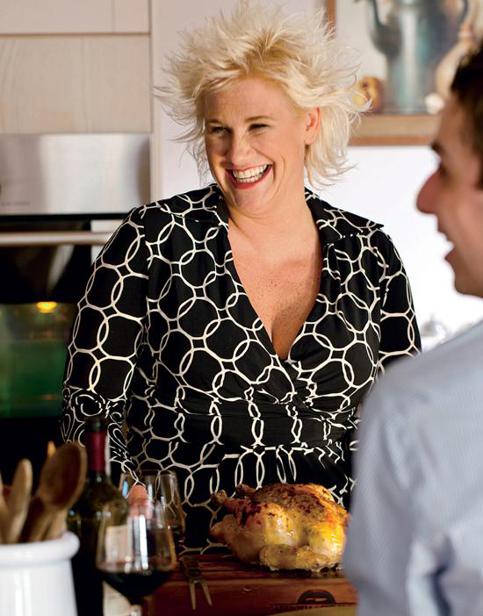Cook Like a Rock Star (26 page)
Read Cook Like a Rock Star Online
Authors: Anne Burrell

Farrotto with Lobster, Peas, Mint & Oregano

SERVES: 4 TO 6 • TIME: ABOUT 1½ HOURS
Farro is an ancient grain that’s used in traditional Tuscan and Umbrian cooking—kind of like a cross between barley and wheat berries. I love making farro in the style of risotto—a.k.a. farrotto. By using my
Risotto-Without-a-Recipe technique
and substituting farro for rice, you end up with something rich and chewy and nutty all at the same time. Like risotto, farrotto is a blank canvas for whatever you’re feeling passionate about. Whatever ingredients are in season, whatever flavors you’re in the mood for, whatever’s freshest. Whenever I cook for big events and have to feed a lot of people, I always make farrotto because it’s quick, it doesn’t cost a lot, and it’s a huge crowd pleaser. It’s a win-win-win.
MISE EN PLACE
FOR THE LOBSTERS
Extra virgin olive oil
1 onion, coarsely chopped
2 celery ribs, coarsely chopped
2 carrots, coarsely chopped
3 cloves garlic, smashed
1 lemon, cut in half
1 thyme bundle, tied with butcher’s twine
Kosher salt
2 1¼- to 1½-pound lobsters
FOR THE FARRO
Extra virgin olive oil
1 onion, cut into ¼-inch dice
Kosher salt
2 cups semipearled farro
2 cups white wine
Lobster stock, as needed (reserved from cooking the lobsters)
2 cups shelled English peas
3 sprigs of fresh mint, leaves cut into a
chiffonade
3 sprigs of fresh oregano, leaves chopped
2 tablespoons unsalted butter
⅓ cup freshly grated Parmigiano
FOR THE LOBSTERS
1
Coat a large tall pot with olive oil, toss in the onion, celery, and carrots, and bring to medium-high heat. Cook until the veggies are soft and aromatic, 8 to 10 minutes. Add the garlic and cook for another 2 to 3 minutes. Fill the pot with water and toss in the lemon halves and the thyme bundle; season lightly with salt. Bring the pot to a boil (BTB) and add the lobsters; cover and cook for 12 minutes.
2
Use tongs to remove the lobsters from the pot and set them aside (save the cooking water!). When the lobsters are cool enough to handle, remove the meat from the shells and add the shells back to the lobster pot; simmer for 30 minutes. Strain the shells and veggies from the cooking liquid. Voilà—you’ve made lobster stock! If you’re using this right away, keep it hot. If not, freeze it.
3
Cut the lobster meat into bite-size pieces and reserve.
FOR THE FARROTTO
1
Coat a large wide pot generously with olive oil, add the onion, and season with salt. Bring the pan to medium-high heat and cook the onion until soft and aromatic, 8 to 10 minutes.
2
Add the farro and cook, stirring frequently, for 5 minutes. Add the wine; it should cover the surface of the farro. Continue to cook, stirring frequently, until the wine is totally absorbed, 5 to 7 minutes.
3
Add enough hot lobster stock to the pan to cover the surface of the farro; stir to combine. Taste for seasoning and adjust if needed. Cook, stirring frequently, until the lobster stock is absorbed, repeat this process two more times, then add the peas.
4
After the last addition of stock has been absorbed, taste the farro. If it’s firm or dry, add a little more stock and cook a little longer.
5
When the farro is tender, add the lobster meat, mint, oregano, butter, and Parm and stir vigorously. REALLY WHIP IT! This will set the perfect texture of the farro. Taste to make sure it’s delicious and serve.
Farrotto—it’s FAR out!
Killer Mac & Cheese with Bacon

SERVES: 6 TO 8 • TIME: ABOUT 50 MINUTES
Everyone thinks of mac and cheese as comfort food, but there’s a lot of bad mac and cheese out there, and frankly, that food makes me UNcomfortable! Great mac and cheese should be creamy and tangy and luscious—it should get me excited with every bite. I promise that this recipe is what mac and cheese should be. And it’s got bacon! What could be better?
MISE EN PLACE
Extra virgin olive oil
6 slices bacon, cut crosswise into ½-inch strips
3 tablespoons unsalted butter
1 onion, cut into ¼-inch dice
Kosher salt
½ cup all-purpose flour
1 quart whole milk, plus more as needed
1 pound shells or other short pasta
2 cups freshly grated Cheddar cheese
2 cups freshly grated Fontina cheese
1 cup freshly grated Parmigiano
¼ cup Dijon mustard
Tabasco or other hot sauce, to taste
1
Drizzle a bit of olive oil in a large saucepan, add the bacon, and bring the pan to medium heat; stir the bacon occasionally. When it’s brown and crispy, 6 to 8 minutes, remove it from the pan, drain on paper towels, and reserve that deliciousness. Do not discard the bacon fat!
2
Add the butter and onion to the pan with the fat, season with salt, and cook until the onion is soft and aromatic, 8 to 10 minutes. Add the flour and cook, stirring frequently, for 4 to 5 minutes or until the mixture looks like wet sand. Slowly whisk in the milk, season with salt, bring to a boil (BTB), and reduce to a simmer (RTS); cook over low heat for 8 to 10 minutes more or until the mixture is slightly thicker than heavy cream.
3
In the meanwhile, bring a large pot of well-salted water to a boil. Add the pasta to the boiling water and cook for 1 minute less than the instructions on the package suggest. Taste it: It should be toothsome with just a little nugget of hard pasta still in the center—this is al dente. Drain the pasta and reserve.
4
Add the Cheddar, Fontina, and Parmigiano to the milk mixture and whisk to combine. Add the mustard and a few shakes of Tabasco; taste and adjust the seasoning if needed, adding a little more milk if the mixture seems too thick. Stir in the cooked bacon and pasta. The mixture should be very creamy and flavorful. Serve immediately or transfer to a baking dish or ramekins and reheat in a 375°F. oven.
Now that’s killer!
The thing about seconds, or main courses, is that often by the time I get around to eating them, I’ve had too many appetizers and too much wine and I’m just not that hungry anymore. I guess sometimes I should just start with seconds because I do love them—after all, they’re the main event!
As a chef, I find that seconds challenge me creatively in a way that piccolini or firsts don’t. Because they feature a larger portion of protein, I’m always trying to think of unique and interesting ways to make a steak or a piece of chicken exciting. Getting creative with a bigger hunk of protein requires skill and thoughtfulness; you have to use your imagination and a variety of different cooking techniques to make the main event new, enticing, and seductive over and over again.
In my experience, knowing how to add flavor while maintaining the integrity of the protein is essential for a great main course. I’m not much of a sauce girl, so for me, adding flavor means relying on marinating, dry rubbing, and beautiful brining! I’m always thinking: How can I use the skills I have as a chef to take what’s freshest and make it taste fabulous and new at the same time?
That’s why, in addition to cooking skills (which I’ll share with you), seasonality is the key to making special main courses. Using the best ingredients available—what’s in season—to showcase a piece of meat or fish can take a good main course and turn it into a showstopper.
For me, every season is like an old friend coming back to visit. What I do with a pork chop in the wintertime is not the same as what I do with it in the spring. Not only do my techniques change, but my ingredients change too. In the summer I’m more inclined to grill or sauté and serve the main course with produce fresh out of the garden, ingredients at their peak of perfection. When it’s hot out I want to enjoy the weather! I want to get outside, put some Prosecco or beer on ice, throw some lovely fish and glorious veggies on the fire, and just let Mother Nature’s bounty shine as simply as possible.



